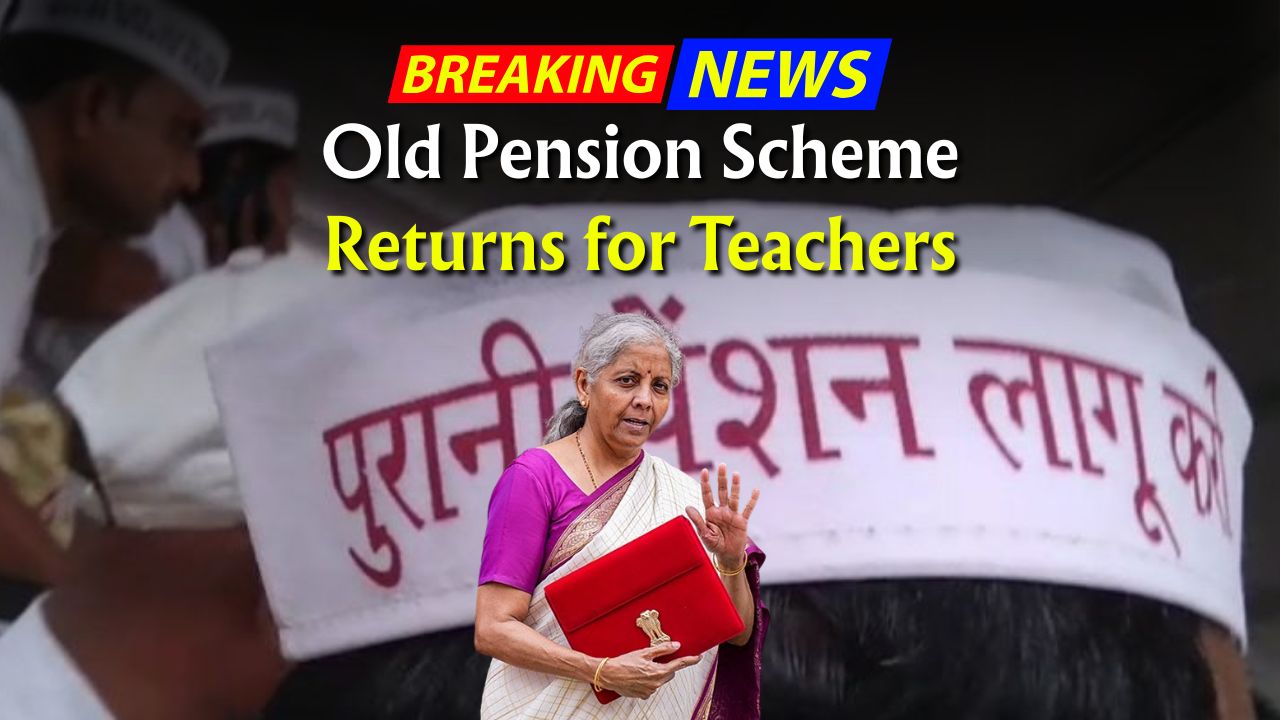Old Pension Scheme – In a landmark decision that has brought immense relief to thousands of government school teachers, the government has officially reinstated the Old Pension Scheme (OPS). This move comes after persistent demands, protests, and legal battles by teachers’ associations across multiple states. With the rollback of the New Pension Scheme (NPS) for specific groups, eligible educators can now look forward to guaranteed monthly pensions after retirement, providing much-needed financial stability.
What Is the Old Pension Scheme (OPS)?
The Old Pension Scheme (OPS) is a retirement benefit plan under which government employees receive a fixed monthly pension after retirement, calculated based on the last drawn salary. Unlike the market-linked New Pension Scheme (NPS), the OPS guarantees lifetime income, ensuring financial security in old age.
Key Features of the Old Pension Scheme:
- Guaranteed lifetime pension after retirement
- No contribution from the employee’s salary
- Pension amount is 50% of the last drawn basic pay + DA
- Includes dearness relief adjustments
- Covers family pension after employee’s demise
- Not linked to market fluctuations
- Funded entirely by the government
Who Will Benefit from the Restoration?
The restoration primarily applies to teachers appointed before a specific cut-off date who were shifted to NPS under administrative changes. The reinstatement of OPS is expected to benefit thousands of teachers across states like Punjab, Rajasthan, Chhattisgarh, and Himachal Pradesh, with more states likely to follow.
Beneficiary Categories:
- Teachers appointed before January 1, 2004
- Teachers who were initially under OPS but later moved to NPS
- Teachers who have completed more than 10 years of service
- State government-employed teachers covered under GPF earlier
- Those who have been part of legal battles for pension rights
Comparison: Old Pension Scheme vs New Pension Scheme
| Feature | Old Pension Scheme (OPS) | New Pension Scheme (NPS) |
|---|---|---|
| Pension Type | Fixed Monthly Pension | Market-Based Pension |
| Employee Contribution | Not Required | 10% of Basic + DA |
| Government Contribution | Full Pension Funded by Govt. | 14% of Basic + DA |
| Market Risk | No | Yes |
| Post-Retirement Benefits | Guaranteed | Variable (based on corpus) |
| Death/Family Pension | Available | Limited |
| Commutation Option | Yes | Partial Withdrawal Possible |
| Tax Benefits | Limited | Available under Sec 80C & 80CCD(1B) |
State-Wise Implementation of OPS for Teachers
Several states have started restoring OPS for their teaching staff, especially after mounting pressure from unions and public opinion.
| State | Status of OPS Restoration | Approx. Teachers Benefited | Year of Implementation |
|---|---|---|---|
| Punjab | Implemented | 1.5 Lakh | 2023 |
| Rajasthan | Implemented | 2.0 Lakh | 2022 |
| Chhattisgarh | Implemented | 1.2 Lakh | 2023 |
| Himachal Pradesh | Announced | 90,000 | 2023 |
| Jharkhand | Under Review | 70,000 | – |
| West Bengal | Pending | 60,000 | – |
| Maharashtra | Under Pressure | 1.8 Lakh | – |
| Tamil Nadu | Opposition Growing | 1.0 Lakh | – |
Why Teachers Opposed the New Pension Scheme
Teachers across India have consistently expressed dissatisfaction with the NPS due to its unpredictable nature and dependency on market performance. Many retired teachers under NPS reported insufficient pension amounts, leading to financial hardship.
Major Concerns with NPS:
- Uncertainty of pension amount
- Inadequate monthly income post-retirement
- No full family pension after death
- Risk of market-linked investments
- Long delays in pension processing
Government’s Statement and Future Outlook
Government officials have acknowledged the concerns of teaching staff and justified the move as a step towards honoring long-standing commitments. According to sources, the restoration of OPS will not only ensure social security for retired teachers but also boost morale among existing educators.
There is also growing momentum in other sectors demanding similar rollback of NPS, particularly from police personnel, health workers, and clerical staff. Future policy adjustments may consider wider implementation of OPS or hybrid models.
Financial Implications for the Government
While OPS ensures better financial stability for employees, it also brings long-term fiscal challenges for the government due to non-contributory commitments. However, the social and political pressure has made it imperative to prioritize welfare over fiscal savings.
| Factor | Old Pension Scheme | New Pension Scheme |
|---|---|---|
| Long-term Govt Liability | High | Low |
| Budget Predictability | Difficult | Easier |
| Employee Satisfaction | High | Low |
| Administrative Complexity | Low | High |
| Retirement Corpus Control | Government-held | Employee/Trust-held |
The restoration of the Old Pension Scheme for teachers is a massive relief for thousands of educators who have been demanding secure retirement benefits. While this marks a significant policy reversal, it reflects the growing public sentiment that retirement should be risk-free and dignified, especially for those who have spent decades in public service. As more states come under pressure to follow suit, the OPS vs NPS debate is likely to dominate the policy discourse in the years to come.
FAQs about Old Pension Scheme
Q1. Who is eligible for the restored Old Pension Scheme?
Teachers appointed before January 1, 2004, or those originally under OPS and later shifted to NPS are eligible.
Q2. Which states have implemented OPS for teachers?
States like Rajasthan, Punjab, Himachal Pradesh, and Chhattisgarh have already implemented OPS for government teachers.
Q3. How is OPS different from NPS?
OPS provides a fixed monthly pension after retirement, while NPS offers market-linked returns without a guaranteed amount.
Q4. Will new teachers be covered under OPS?
No, the restoration applies only to those who meet the eligibility criteria; new hires post-2004 remain under NPS unless notified otherwise.
Q5. What are the main benefits of OPS?
Guaranteed pension, family pension benefits, no market risk, and complete government funding are the major benefits of OPS.
